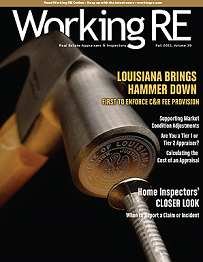 |
>> See Past News Editions >> Click to Print >2016-2017 TAF Approved USPAP Online Enroll Now! (7 hours – $143.95) >FHA Checklist/Field Guide |
USPAP: Shifting (Quick) Sand for Appraisers
By Bob Keith, MNAA, IFA
If you’re like me, you make a decision about whether to read an article in a magazine based on its title and the first few sentences. If you’re an appraiser, then you should keep reading.
Before you do, however, it would be beneficial to understand exactly who is delivering this message to you. If you are a professional appraiser, enough said! We’re on common ground but there is more. After earning a bachelor’s degree in Real Estate and Urban Land Development in 1981, I embarked on a career as a professional appraiser which I did for 21 years, mostly in the residential mortgage lending arena.
About 10 years later, I was honored to be a gubernatorial appointee to the first Oregon Appraiser Certification and Licensure Board in response to the FIRREA mandate that all states license/ certify real estate appraisers for the protection of public trust. For many years after my time on the board, I served as a member of its Appraisal Review and Advisory Council, which is a peer review committee used by the board at that time in its complaint investigation process.
Subsequently, I served 12 years as the Executive Director of the Oregon Appraiser Certification and Licensure Board. During this time I was an AQB Certified USPAP Instructor. Prior to my employment with the Oregon board, I taught pre-license appraiser education coursework for what was at the time the largest provider of appraiser qualifying education in the country, while owning and operating a 13-person appraisal firm with multiple offices.
During my service to the Oregon board I was involved as a board member, officer and President of the Association of Appraiser Regulatory Officials (AARO), and during that time I represented AARO on The Appraisal Foundation and Advisory Council (TAFAC) as an officer and later its Chair in 2010.
One of my primary responsibilities with the Oregon board was to investigate complaints against appraisers, make decisions about whether USPAP violations occurred, and represent the board in the prosecution of alleged USPAP violations by appraisers.
Since I left the employment of the board in 2013, I have consulted with many appraisers across the country who were defending themselves against complaints filed against them by various parties who felt aggrieved by the appraiser. During this time it has become apparent to me that many state appraisal boards lack appraisal and/or USPAP expertise on staff. And those with whom the boards subcontract to make decisions about USPAP violations are not sufficiently knowledgeable in USPAP to make those determinations.
Just today I was reviewing a case from a northern state in which the “independent contractor” hired by that state to perform a “review” on an appraisal report criticized my client for including a copy of his E&O insurance binder in his report because, “an appraiser should never include liability insurance declarations within a report; it invites litigation.” Just in case you were wondering, no, this is not a USPAP violation! Nevertheless, this reviewer was the “expert” that state appraiser board was relying on to tell them where the appraiser erred. Often times USPAP is not applied consistently within a state or in comparison with other state appraisal boards for the same or similar (alleged) violations.
(story continues below)

(story continues)
Moving Target
Exacerbating this problem is the fact that USPAP has changed too much in a short period of time to be considered as a legitimate minimum standard for professional appraisal practice. Not only is USPAP a moving target for appraisers, it is also a moving target for those charged with enforcing it. If USPAP really is the minimum set of professional appraisal standards, then it’s like a house built on shifting sand. Consider the following: in the beginning we had the Departure Provision (later it became the Departure Rule) because at that time it was considered to be important to communicate whether a “complete” appraisal process was conducted, or something “less than or different from” the complete process (i.e. a “limited” appraisal).
Then, in 2006, the Departure Rule was deleted “to resolve misunderstandings related to Departure and public trust…” (2006 USPAP Page V). Apparently, the Departure Rule turned out to be not such a good “minimum standard,” so the Appraisal Standards Board (ASB) decided to replace it with a two-page Scope of Work Rule. That’s good—a clear, concise “minimum standard,” except it required a four-page (non-binding) advisory opinion (AO28) to provide “guidance from the ASB…to illustrate…and offer advice” on the twopage binding Scope of Work Rule.
In 2001 the ASB added Statement 10 to USPAP “to provide clarification, interpretation, explanation, and elaboration to reaffirm an appraiser’s USPAP obligation when performing assignments” for federally related transactions (2001 USPAP page VI). Statement 10 was so large that it had its own table of contents and it became a new binding minimum standard.
But then, in the 2008–09 edition of USPAP, Statement 10 was retired because according to the ASB (the author of USPAP), “The Statement did not distinguish between laws (such as FIRREA), regulations and guidelines (such as the Interagency Appraisal and Evaluation Guidelines), resulting in confusion for both appraisers and users of appraisal services.” And “The format and complexity of Statement 10 were obstacles to its understanding and effective enforcement”… and “Substantial editing of Statement 10 would not have resulted in increased understanding” (2008–09 USPAP page U-vi).
Some of the issues that were in Statement 10 were moved to a new, non-binding Advisory Opinion (AO30) which now offers guidance and advice on the same issues. Keep in mind that USPAP Advisory Opinions are nonbinding and not part of USPAP.
Also in the 2008–2009 edition of USPAP the definition of Supplemental Standards and the Supplemental Standards Rule were deleted from USPAP. According to the ASB (2008- 09 USPAP page U-vi), “Appraisers must comply with laws and regulations because of the nature of law itself, not because of USPAP. Thus, continued use of Supplemental Standards as defined by the term was unnecessary.”
As of January 1, 2016 (the effective date of the 2016–2017 edition of USPAP), all of the binding Statements on Appraisal Standards will be retired. Remember that the Statements were originally added to USPAP to “to provide clarification, interpretation, explanation, and elaboration” of USPAP.”
According to the ASB: “After evaluating the content of the five remaining Statements, the Board (ASB) concluded that most of the content was guidance. In order to make USPAP a clearer, more user-friendly document, the Board retired all of the remaining Statements. The ‘few requirements’ that were in the Statements were moved into other parts of USPAP and the guidance was reissued in the form of new Advisory Opinions” (USPAP 2016–2017 page Vii.). So those “few requirements” that were formerly binding requirements then became “non-binding” guidance in the Advisory Opinions.
What message does it send when the author of professional standards (the ASB) uses words like the following to describe past minimum standards of practice: “confusing,” “misunderstandings” and “obstacles to…understanding and effective enforcement;” “editing… would not have resulted in increased understanding” and “continued use of… [the standards] as defined by the term was unnecessary.”
While there may be only one set of appraisal standards of practice effective at any given time, in reality USPAP changes so frequently and so significantly that it is very difficult for appraisers and regulators to keep up. One could say that there is nothing “uniform” or “standard” about the Uniform Standards of Professional Appraisal Practice, at least not over time.
Let the Sentence Fit the Crime
One might ask: “What is the solution to the problem of USPAP being like shifting sand?” I honestly don’t know. All I know for sure is what I have seen and experienced myself, that many appraisers have been sanctioned by their state appraiser boards for violations of minimum standards of practice (at the time) for which it was later decided that those standards were deemed “confusing… obstacles to understanding/enforcement and/or unnecessary.”
Why is this important? Well, how would you feel to be one of those appraisers who was sanctioned by your licensing board for a violation of minimum standards that were subsequently deemed to be, “confusing… obstacles to understanding/enforcement and/ or unnecessary.” Those who have been sanctioned by their state boards report significant consequences that vastly exceed the actual “punishment” that was meted out by their state board.
For example, suppose an appraiser is found to be in violation of several USPAP requirements that result in a $1,500 fine plus a requirement to take one 30-hour appraisal class. On its face, that’s not such a bad result. Particularly, in comparison with the cost to hire an attorney to challenge the case through the administrative hearing process. Remember, this is the “punishment” deemed appropriate by the state licensing board for the crime. What that board doesn’t often consider is that the true consequences for “the crime” far exceed their determination of appropriate punishment (fine and a class).
Appraisers who have been disciplined by their state boards, even for relatively minor transgressions, report that their E&O insurance premiums increase— sometimes dramatically, that they are denied approval on potential new-client fee panels, dropped from existing client fee panels, and/or are disqualified as expert witnesses in litigation-support assignments. The cumulative financial and reputational effects far outweigh the $1,500 fine, $350+/- class, plus the loss of one week’s earnings on the job.
For many years, what appraisers have had in terms of stable minimum professional standards of practice and ethics is not only not perfect…but in fact is far from perfect and has had serious professional consequences for many appraisers.
Free Webinar!
Click here to watch “Fighting Appraisal Board Complaints: An Expert’s Advice” presented by Bob Keith for FREE this holiday season. Happy Holidays!
About the Author
Bob Keith, MNAA, IFA, is an AQB Certified USPAP Instructor, Certified General Appraiser, former Executive Director of the Oregon Appraiser Board, past President of the Association of Appraiser Regulatory Officials, past Chair of The Appraisal Foundation Advisory Council, and has served as a subject matter expert for two national appraiser exam providers. Mr. Keith currently serves as the Treasurer of the National Association of Appraisers. Keith also offers consulting to appraisers nationwide facing state board complaints. OREP Members receive a FREE 1/2 hour consultation with Bob Keith and 25% off his consulting services.
>Click to Print
>New: Collateral Underwriter Blog: Find answers, offer solutions.
>Opt-In to Working RE Newsletters
Send your story submission/idea to the Editor: isaac@orep.org



